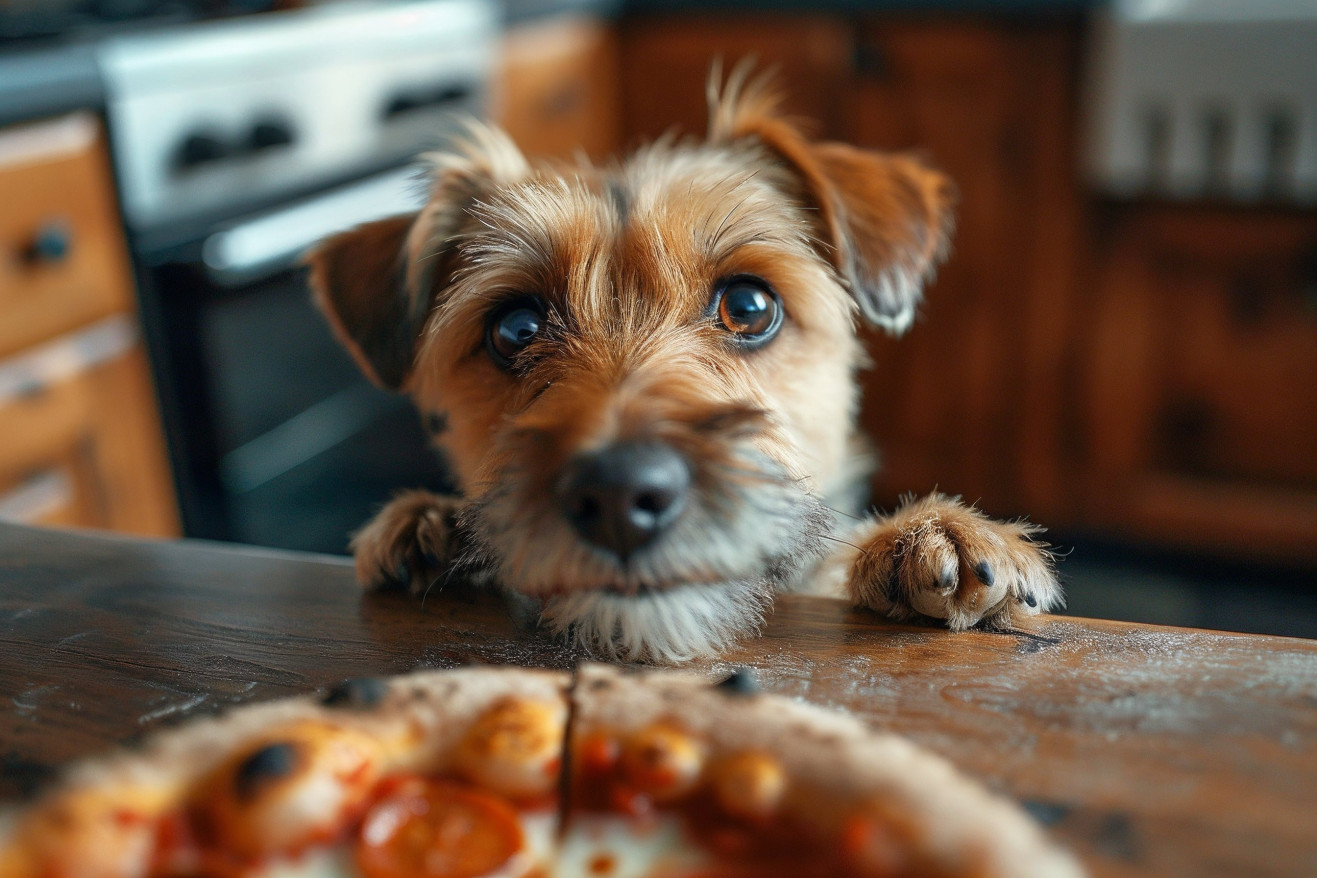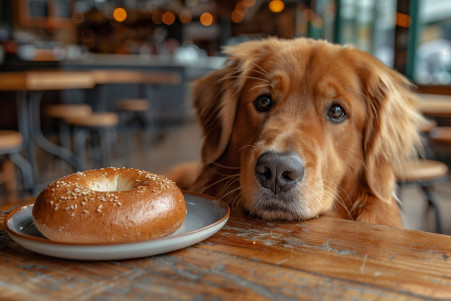Can Dogs Eat Pizza Crust? Unpacking the Risks for Canine Health
15 February 2024 • Updated 14 February 2024

If you’ve ever wanted to give your dog the last bite of your pizza crust, you may have wondered if it’s safe. While it’s best to err on the side of caution and avoid giving your dog pizza crust, there are a number of reasons why it’s not the best choice for your pet.
For one, pizza crust can contain toxic ingredients like onions, garlic, and too much salt, all of which can be harmful to dogs. On top of that, pizza crust has no nutritional value for dogs and is high in carbohydrates.
In the sections below, we’ll take a look at veterinary nutritional research and studies on the canine diet to understand why pizza crust isn’t recommended for dogs. We’ll also look at the differences between the human and canine digestive systems, the potential dangers of some of the most common pizza crust ingredients, and some healthier alternatives that will help you ensure your dog gets the nutrients they need.
Let’s take a look at the scientific research that will help you make sure you’re feeding your dog in a way that supports their health and well-being.
Can dogs eat pizza crust?
Meeting a Dog’s Nutritional Requirements
A dog’s diet needs to be balanced and include proteins, fats, carbohydrates, vitamins, and minerals to meet their nutritional needs. As VCA Animal Hospitals explains, proteins are necessary for tissue growth, fats are a source of energy, carbohydrates are used for immediate energy, and vitamins and minerals are important for a variety of physiological processes.
A diet that is high in fats, salts, and simple carbohydrates, like the ones found in pizza crust, can lead to obesity and other health problems in dogs.
Many human foods don’t provide the nutritional balance that dogs need. For example, the ingredients in pizza crust may be satisfying to humans but they don’t provide the nutrients that dogs need.
As PetMD points out, a dog’s diet needs to be based on their individual energy requirements, which can vary based on their age and activity level.
Feeding dogs human food like pizza crust without considering their specific nutritional needs can lead to unintended health problems. As a result, it’s important to understand and meet a dog’s nutritional needs to ensure their health, which means that it’s important to look at alternatives to pizza crust.
The Dangers of Pizza Crust for Dogs
While your dog may see pizza crust as a fun and tasty treat, the ingredients in pizza crust can be very dangerous. The refined flour in pizza crust is not only nutritionally void, but the high carbohydrate content can lead to weight gain.
More importantly, however, is the presence of yeast. As Preventive Vet explains, yeast in raw dough can expand in a dog’s stomach and cause life-threatening bloat. In addition, yeast fermentation produces ethanol, which can lead to alcohol poisoning in dogs, which can cause seizures and respiratory failure.
Salt, which is also commonly found in pizza crust, can be toxic to dogs and lead to sodium ion poisoning, which can impact the cardiovascular and nervous systems. This is especially true for dogs with pre-existing heart conditions. Meanwhile, sugar and fats can contribute to obesity and other health issues, including diabetes.
Finally, dogs can also be allergic or sensitive to wheat or gluten, which can lead to gastrointestinal upset and other symptoms. Because of these risks, which range from acute poisoning to chronic health conditions, it’s best for people to eat pizza crust and not give it to their dogs. Knowing about these risks can help dog owners make choices that will keep their pets safe and healthy.
Canine Digestion: Shaped by Size, Not Like Ours
Dogs have digestive systems that have evolved to meet their specific dietary needs, which are very different from human dietary needs. According to a study in PubMed Central, dogs have a digestive anatomy that’s adapted to a carnivorous diet, with a stomach and intestines that are well-suited to breaking down proteins and fats.
However, studies found on Google Scholar show that dogs have also evolved to tolerate diets high in starch due to domestication, although this is a trait that’s less common in wild canids.
In contrast, humans have a much longer gastrointestinal tract that’s well-suited to a more omnivorous diet that includes a high percentage of carbohydrates. This means that the common ingredients in pizza crust, which are often high in carbohydrates, aren’t a great source of energy for dogs and may be difficult for them to digest.
In addition, the impact of a dog’s size on its digestive physiology is also important to note. A study in PubMed Central found that larger breeds may be more efficient at digesting fiber than smaller breeds, which means that a one-size-fits-all approach to dog diets, including the treats you give them, is unrealistic.
Given these major differences in digestive systems, dog owners need to be sure to choose foods that are suitable for their dog’s size and digestive system.
Yummy and Nutritious: Healthy Snack Options for Your Dog
If you’re looking to spoil your dog with a treat, your kitchen is full of healthy options that are safe and good for your pet. For example, carrots are not only good for your dog’s teeth, but they’re also high in vitamin A, which is important for the immune system and skin and coat health, according to Medical News Today.
Apples, when the core and seeds are removed, contain vitamins A and C and fiber, which is good for digestion.
Lean meats like unseasoned, boiled chicken are easy-to-digest protein sources that can be especially soothing for dogs with sensitive stomachs. Fish like salmon, which is high in omega-3s, according to a 2001 study, can help support the immune system, but it should be cooked and free of bones.
When you introduce these treats, do so slowly and watch your dog’s reaction to make sure they don’t have any sensitivities. It’s also important to remember that these treats should make up no more than 10% of your dog’s daily caloric intake, according to the Clinical Nutrition Team at Cummings School.
Taking your dog’s age, size, and health into account when choosing treats will help you make sure you’re keeping your dog’s diet in balance and supporting their overall well-being.
When you choose these healthy snacks over a piece of pizza crust, you’re not only supporting your dog’s health, but you’re also catering to their taste preferences. Making sure your dog has a well-rounded diet that meets their nutritional needs will help make sure they’re happy and healthy and ready for their next big adventure.
Final Thoughts on Fido’s Feast
As we’ve discussed throughout this article, while pizza crust may be a delicious indulgence for us, it’s dangerous and nutritionally void for our dogs. Many of the ingredients in pizza crust, including refined flour, yeast, salt, sugar, and fats, can lead to a variety of health problems, including obesity, sodium ion poisoning, and alcohol toxicity from yeast fermentation.
Moreover, dogs have very different digestive systems than humans and need a diet that’s high in proteins and certain fats, not one that’s high in simple carbohydrates and salts.
It’s important for us as pet parents to understand and honor our dogs’ unique dietary requirements. Giving dogs pizza crust or any other human food that doesn’t meet their nutritional needs can put their health at risk. It’s essential to work with a vet to get personalized dietary recommendations so that you can be sure that the treats and snacks you give your dog are both safe and healthy.
In short, it’s important to practice mindful feeding that prioritizes the health and well-being of our canine companions, and this is a way to show that we care for them and want to support their health and happiness.


